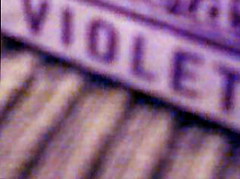White, Patricia. unInvited: Classical Hollywood Cinema and Lesbian Representablitity. Bloomington and Indianapolis: Indiana University Press, 1999.
This book belongs to a second generation of feminist and queer film theory, following and critiquing the work of scholars such as Mary Ann Doane, Richard Dyer and Teresa De Lauretis, and she has no qualms about harshly contradicting her predecessor's "missreadings," though sometimes the scholarship she quotes appears more significant and interesting than that she provides.
White's readings of classic films are spectacular; she beautifully parses the symbolic systems that codify certain stars and roles as queer despite the unrepresentability of lesbianism under the Hays Code. White focuses on analysis of films from this period, roughly 1930-1960, and demonstrates the ways in which lesbians were representable even though it takes some careful reading to discern them. She focuses on 'women's films,' gothic horror, and the asexual sidekick, villian, and other 'character roles.' She also alludes to but doesn't engage with the gossip of lesbian that is part of certain 'star images' such as Marlene Dietrich, Greta Garbo, and Agnes Moorehead (Endora on Bewitched). One of the things I learned that besides unmarried women in roles such as nanny, governess, or spunky secretary as lesbian types, you can also spot lesbians by a tendency to wear either leopard print or tweed. I knew I needed more tweed in my wardrobe!
White introduces the concepts of the "femme film" and "retrospectatorship," both of which I wish she would have more thoroughly explored. The "femme film" seems to mean films the 'woman's film' genre (the pre-1950s version of the 'chick flick') "that sustain lesbian inference" (xviii). It raises questions of the lines between homosociality and homosexuality (when does female bonding cross into 'lesbian inference'?) and emphasizes that while butch women were fairly unrepresentable, a lot could be explained away as normative femininity as long as the women seemed appropriately gendered. White, however, doesn't seem to want to consider lesbians too closely in butch-femme dyads or even necessarily discuss whether or not two women are necessary to make lesbianism visible. After introducing the term, she doesn't seem to continue to interrogate it throughout the book, and I would like to know more. "Retrospectatorship" more or less appears only in the last chapter, and again seems fascinating but underdeveloped. This concept implies that we now watch old films through a general cultural perception of them; no one can watch Bette Davis in All About Eve without some perception of camp appropriations of her persona. We view classical Hollywood cinema through contemporary lenses and thus get more intertextuality and a richer experience. These classical films are part of what shapes contemporary queer identities and visibility, and thus we view the films through those conceptions of identity. Mrs. Danvers in Rebecca seems to be an evil and obsessed lesbian in part because that's the way that queer relationships were representable at the time and partially because that's how we've learned to see queer relationships through that representation. It's a fascinating concept, and I'm not sure White gave me enough to really understand or commit to it. I suspect I'll have to come back to this book and try skip the fascinating readings of old films and try to sort out the theory.
My 2025 in Review
-
Hi Friends! Happy Holidays! Here is my 2025 rundown.
Another year of being a full time playwright! It's been about 2 and a half
years now. I feel li...
1 week ago

0 comments:
Post a Comment